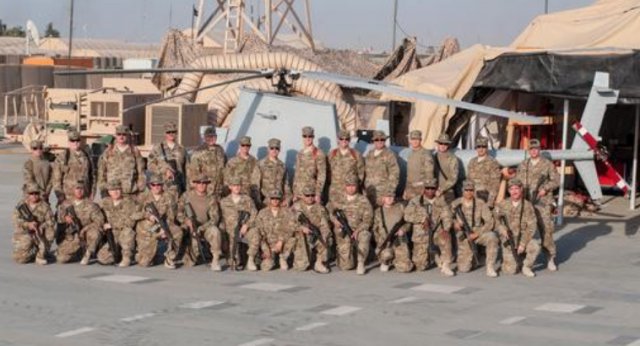 Manned aircraft have dominated the Navy for the last century; however, the use of unmanned aircrafts has been rising recently along with the demand for those who know how to operate and maintain them.
Manned aircraft have dominated the Navy for the last century; however, the use of unmanned aircrafts has been rising recently along with the demand for those who know how to operate and maintain them.
Lt. Cmdr. David Avery, a Navy reservist and former SH-60B pilot, deployed to Afghanistan last year to support the Navy’s Fire Scout unmanned helicopter detachment as the unit’s officer-in-charge (OIC).
When he joined the detachment in December, the MQ-8B Fire Scout had been providing an intelligence, surveillance and reconnaissance capability in the U.S. Central Command area of responsibility for less than one year. Most of the people joining the unit had little or no experience working with unmanned systems.
“They were all brand new to Fire Scout,” Avery said. “They received their training [at Northrop Grumman’s facility] in Hollywood, Md., and did some pre-deployment training at Webster Field with the [UAS] test directorate prior to reporting to our location in Afghanistan.”
“Operating and maintaining a UAV is different than flying a manned aircraft, and it takes a different mindset,” said Navy reservist Lt. Chris Shams, the detachment’s assistant OIC. “We definitely had a bit of a learning curve every time we transitioned personnel. Our team had to get up-to-speed very quickly on how to use this system to support critical missions for our customer.”
Reflecting on his experience as a maintenance duty officer, Shams pointed out that UASmaintainers not only maintain the aircraft, but they also need to manage the ground control station.
“If the aircraft is up and the ground control station is down, you are not flying,” he added.
In late spring of this year, many of the maintenance and operations officers from Northrop Grumman transitioned to government personnel, resulting in an increase of Fire Scout experts in the Navy community.
“We received a lot of interest on this deployment,” said Cmdr. Manny Picon, Fire Scout team lead in Pax River. “They were excited about the mission because they had the opportunity to work on an aircraft with new technology. Our team here was excited to build a cadre of folks that have both operational and developmental expertise.”
The OICs and majority of Navy personnel from the detachment returned to the U.S. last month. The detachment will revert back to a government-owned, contractor-operated unit in alignment with the government’s policy on reduction of the military footprint in Afghanistan.
The skills Navy personnel gained during this deployment will help other units. Avery, for example, who is now serving as an aerospace engineering duty officer in the Navy Reserve, hopes to support the program office in the testing and evaluation of the new MQ-8C model and support the systems engineering team.
“Reservists are being utilized at Webster Field and a few are transitioning to one of the shipboard attachments where Fire Scout is being tested overseas,” Avery said.
Active-duty members from the unit will join Fire Scout’s new Unmanned Helicopter Reconnaissance Squadron (HUQ) 1 in Naval Air Station North Island, Calif. HUQ-1 will train, prepare and provide personnel for future ship-based deployments.
“I want to help the people in San Diego better prepare for future deployments,” Shams said. “I hope the lessons learned from this experience will help guide and direct this new organization.”
Source: The BayNet
